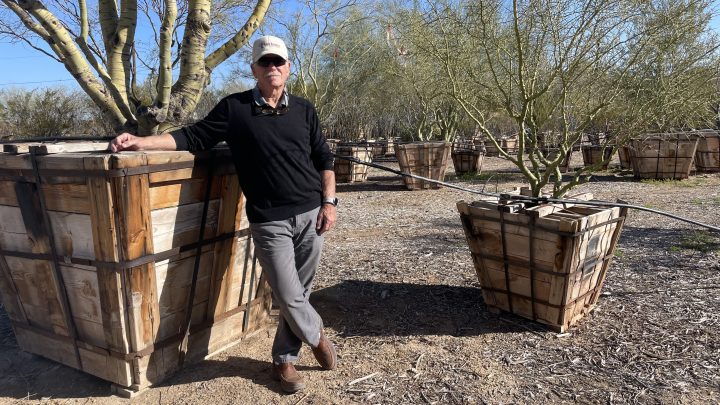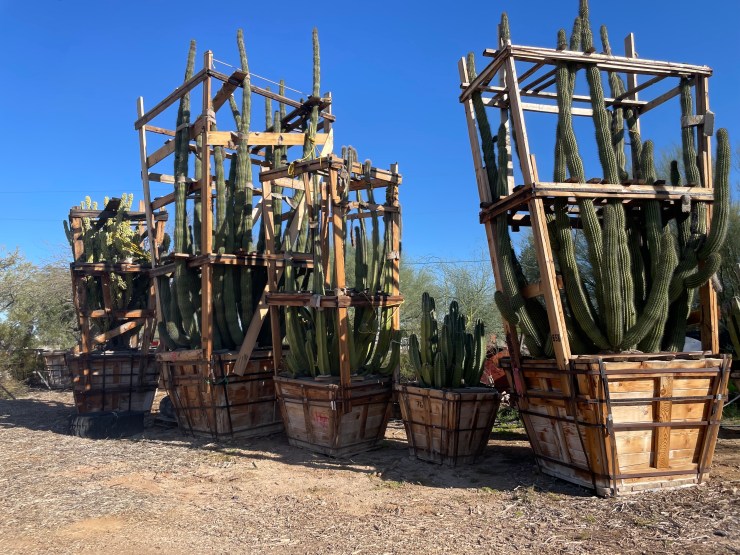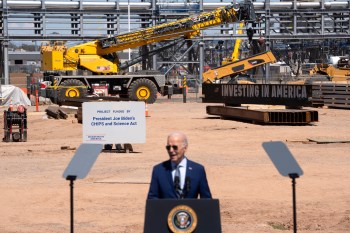
Chip factory growth boughs to native plants in Phoenix
Chip factory growth boughs to native plants in Phoenix

One of the flagship projects in the U.S. government’s effort to rebuild the domestic supply chain for semiconductors lies 25 miles north of downtown Phoenix, on what was, until recently, undeveloped desert.
The Taiwan Semiconductor Manufacturing Co. first announced plans to build a chip factory in North Phoenix in May 2022 at a cost of $12 billion. In the years since the CHIPS and Science Act passed, TSMC has increased that planned investment to more than $65 billion and three factories.
But before construction began on TSMC’s 1,100 acres of desert land, the company had to deal with something else: the native plants that were there first.
“TSMC came here about three years ago, and we had daily calls to Taiwan to explain our system,” said Rob Kater, owner of Native Resources International, a plant relocation, nursery and landscape company. “It was difficult for [TSMC] to wrap their heads around why we have to save the trees.”

The Phoenix metropolitan area lies within the Sonoran Desert, which, according to the National Park Service, has more than 2,000 native plant species, including saguaro cactuses. Saguaros can live up to 200 years and are so synonymous with this area, they’re pictured on Arizona license plates.
In 1981, the city of Scottsdale passed an ordinance barring people from removing certain plants, including saguaros, without a permit. Phoenix and other surrounding cities followed suit, passing ordinances requiring developers to salvage native species and, in some cases, replant them back into the landscape.

Within those local laws, Rob Kater found a niche at the intersection of conservation and development.
“We’re able to monetize the whole program of saving native materials,” he said. Native Resources helps developers inventory plants on their land, identify which need to be preserved, and then salvage, store and replant them back into the landscape once construction is finished.
Kater said the company’s largest customer is a big housing development in an area northwest of Phoenix called Vistancia. “In the Vistancia area, we’ll be doing about [3,000] to 4,000 trees and cacti,” he said. TSMC, recipient of $6.6 billion of federal funding through the CHIPS Act, was a smaller project — about 1,000 trees.
“What we have been able to do with developers is make them understand that not only is there an environmental advantage to saving the trees … there’s also a monetary advantage,” Kater said. “We look at each and every tree as being a living statue.”
Kater said you can’t buy some of these trees in nurseries because they grow too slowly.
Native Resources pulls in $10 million in annual revenue, Kater said.
On Native Resource’s 8-acre lot in North Phoenix, Kater showed “Marketplace’s” Kai Ryssdal and The Washington Post’s Heather Long some of his inventory.
“That tree is called an ironwood tree, it’s about 5 feet in diameter, and it [costs] about $8,000,” he said.

But with Phoenix’s rapid population growth, the value of land underneath those trees is going up. “[This is] an area that 20 years ago was just a cotton farm, but now has been just fully developed,” Kater said.
Across the street from Native Resources, with its rows of ironwood trees and a small army of saguaro cactus spears, there is a Goodwill and a pet care center. Five minutes down the road, there is a big shopping center and a movie theater.
Would Kater consider selling some of his land?
“It is tempting,” he said. “We have actually lost three of our largest nurseries to development because of the numbers that were put in front of them. And that caused an incredible change in our market and our supply when these nurseries that we were all dependent upon turned over and sold to large-scale development.”

Phoenix has gained almost 200,000 new residents since 2020. Kater’s business is facilitating one small part of that change, but with the increased investment in semiconductor factories, more is coming.
“I think the idea is, if change is coming, we need to understand it and get society ready for it,” he said.
In future installments of our series “Breaking Ground,” we’ll also explore the implications of that change on workforce development, culture and the housing market.
Click the audio player above to hear Ryssdal and Long’s conversation with Rob Kater.
There’s a lot happening in the world. Through it all, Marketplace is here for you.
You rely on Marketplace to break down the world’s events and tell you how it affects you in a fact-based, approachable way. We rely on your financial support to keep making that possible.
Your donation today powers the independent journalism that you rely on. For just $5/month, you can help sustain Marketplace so we can keep reporting on the things that matter to you.


















